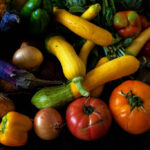As Seen on Forbes.com…
 The subject of pairing wine and food is an infernal one. Well, partially infernal.
The subject of pairing wine and food is an infernal one. Well, partially infernal.
Actually, just putting together a food and wine that taste delicious in each other’s company is really not that difficult. It’s the easy part, in fact!
The hard part is the attitude that comes with the process, the attitude of others. Attitude is rife when one attempts to match food and wine: attitude doled out by the sommelier, your friends, your trusted friends, the dishwasher, and passersby. I’ve heard it all.
Now, whatever most people get on the receiving end of wine and ‘tude is triple for me because I’ve researched the subject carefully, have spent decades trying to figure things out and articulate principles. “Drink the damned wine,” my dearest friends might say. “Save the theoretical drivel for your next article in the Sommelier’s Journal.” “Oh stop, already!” is the most frequent response I get when I mention why Menetou-Salon should go with the oysters.
I smile. I laugh. I so love this renegade spirit. The last thing we need in American restaurants is a cadre of solemn “matchers” bickering about Merlot or Pinot Noir or Nero Mascalese with the porterhouse. I’m way against the hard-core pontificating.
But even my affable, soft-pedal approach seems to piss some people off. I wrote the book Red Wine with Fish in 1989, and I never intended it to be “the wine commandments.” Screw rules, I always said. Don’t want no stinking rules. I want, instead, principles—tasty little tidbits that make thinking about wine with food so much easier. And every once in a while, some “tidbit” comes along that is so ringingly, so absolutely spot-on that, if you plant it in your brain, you are likely to harvest good matching ideas for the rest of your life.
Here’s the key: almost all of my “principles” are founded on interactions between food and wine taking place on your tongue. Sure, there are thousands of aromas/flavors that resonate in your retro-nasal passage, creating a lifetime of memorable responses (truffles, kumquats, a wet horse’s mane, etc.) to be savored on their own, but these elements can only deepen a match, give it interest. They don’t play a major role in figuring out which match. I hate, for example, when pretentious would-be-matchers tell me that the young St. Joseph has “raspberries in the nose…so we have to work ‘raspberries’ into the dish somehow.” Height of absurdity.
The one important thing in that match is the tongue-play. This raspberry-scented wine…is it sweet? Is it dry? The raspberries going into the food…are they sweet? Are they acidic? The protein around which they gather…is it salty? Has it been charred to the point of bitterness on the outside crust?
Aha! These are the questions that matter! For observant tasters will have recognized patterns like these over the course of their lives:
1) If your dry wine is a little too sweet for your taste (say, a big Chardonnay)…cut down that sweet impression by sweetening your food! If the Chard was destined for grilled swordfish with a fresh salsa…but the wine seems too sweet when you taste it with the dish…simply add some fruit (papaya? orange? pineapple?) to the salsa…and the wine will taste drier, with a payload of much more subtle elements revealed. That’s what I call a principle.
2) If your light wine is a little too acidic for you…adjust in the opposite direction! Let’s say you’re planning a salad of lovely greens, to be dressed with a balsamic vinegar dressing. But the acidic wine tastes even more acid next to the sweet balsamic vinegar. The solution? Ixnay on the alsamic-bay. Use tart red-wine vinegar instead of balsamic, to blend with your olive oil into a dressing. When the salad is tart, not sweet…you’ll be amazed what happens to the wine! It stops tasting tart! It gets sweeter, fruitier, shows new ripe flavors! A miracle!
Finally…les artichauts. Fortunately, there’s backup for guys like me who like to tell people that just memorizing a few simple and specific wine-food principles will give you knowledge and strategies for life. The artichoke tells an amazing, didactic story.
Would you do me a favor? Stop reading right here. Get in your car. Go out and purchase a whole, raw artichoke. Trim it just a bit, cook it whole in a pot of water (Julia Child’s Mastering the Art of Cooking, Vol. 1, has all the nitty-gritty details).
For this experiment, you don’t need any sauce or dressing. Just serve the thing hot, or at room temperature, all by itself. After you’ve run a leaf through your teeth, and sucked off the pulpy part at the base of the leaf, you should immediately taste a wine. Maybe several wines. Maybe even a glass of water.
You will find something startling: everything you taste after you’ve tasted an artichoke tastes sweeter. That’s because an artichoke contains cynarin—a natural chemical that makes all succeeding tastes taste sweeter.
This is why artichokes are high on the list of the “no-fly” foods, the ones we are commanded to not serve with wine. Because if you served a 1961 Chateau Margaux with an artichoke, you’d be turning your magnificent, perfectly balanced elder red Bordeaux into something like liquid candy! “No artichokes with wine” is a rule, to some. But if we understand why this is a rule to some…we can work with the match and arrive at a delicious partnership. This is what I call making principles work for you.
Have you ever had a small wine that is forbiddingly dry? Not a trace of sweetness? It can be a severe palate bummer. Some Provençal rosés are that way, as are some “trocken” wines from the Mosel, in Germany.
OK. Here comes the bright light! Serve a wine like this with an artichoke, and you’ll be startled to see what happens. In the tide of post-cynarin physiology…the wine will taste sweeter, rounder, more luscious! I’ve been on the artichoke-with-dry-rosé bandwagon for many years! Wine principles are sometimes slippery, sometimes dribble past your palate. But this one’s a perfect lay-up!
And that’s why I say…we should look to the artichoke as a teacher. One guided experience with an artichoke and a glass of wine, and you’ll not only know what to serve with artichokes, you’ll have confirmed the notion that there are wine-with-food principles out there worth learning!




